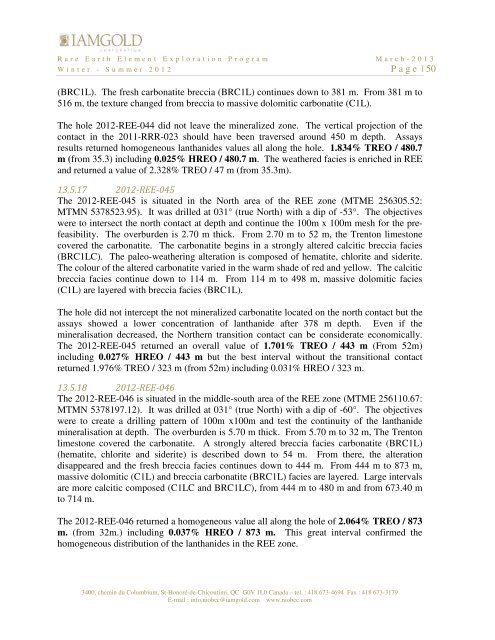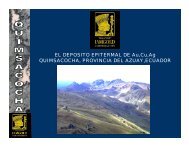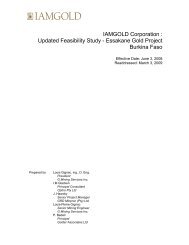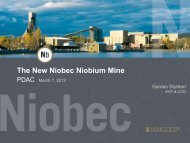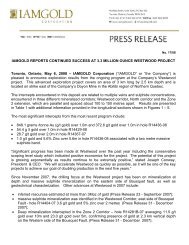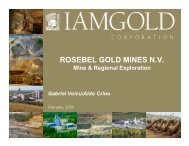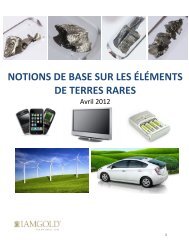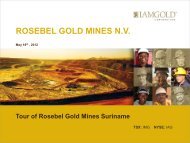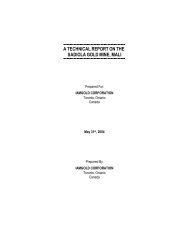NI 43-101 Technical report, Surface diamond drilling ... - Iamgold
NI 43-101 Technical report, Surface diamond drilling ... - Iamgold
NI 43-101 Technical report, Surface diamond drilling ... - Iamgold
You also want an ePaper? Increase the reach of your titles
YUMPU automatically turns print PDFs into web optimized ePapers that Google loves.
R a r e E a r t h E l e m e n t E x p l o r a t i o n P r o g r a m M a r c h - 2 0 1 3<br />
W i n t e r - S u m m e r 2 0 1 2 P a g e | 50<br />
(BRC1L). The fresh carbonatite breccia (BRC1L) continues down to 381 m. From 381 m to<br />
516 m, the texture changed from breccia to massive dolomitic carbonatite (C1L).<br />
The hole 2012-REE-044 did not leave the mineralized zone. The vertical projection of the<br />
contact in the 2011-RRR-023 should have been traversed around 450 m depth. Assays<br />
results returned homogeneous lanthanides values all along the hole. 1.834% TREO / 480.7<br />
m (from 35.3) including 0.025% HREO / 480.7 m. The weathered facies is enriched in REE<br />
and returned a value of 2.328% TREO / 47 m (from 35.3m).<br />
13.5.17 2012-REE-045<br />
The 2012-REE-045 is situated in the North area of the REE zone (MTME 256305.52:<br />
MTMN 5378523.95). It was drilled at 031° (true North) with a dip of -53°. The objectives<br />
were to intersect the north contact at depth and continue the 100m x 100m mesh for the prefeasibility.<br />
The overburden is 2.70 m thick. From 2.70 m to 52 m, the Trenton limestone<br />
covered the carbonatite. The carbonatite begins in a strongly altered calcitic breccia facies<br />
(BRC1LC). The paleo-weathering alteration is composed of hematite, chlorite and siderite.<br />
The colour of the altered carbonatite varied in the warm shade of red and yellow. The calcitic<br />
breccia facies continue down to 114 m. From 114 m to 498 m, massive dolomitic facies<br />
(C1L) are layered with breccia facies (BRC1L).<br />
The hole did not intercept the not mineralized carbonatite located on the north contact but the<br />
assays showed a lower concentration of lanthanide after 378 m depth. Even if the<br />
mineralisation decreased, the Northern transition contact can be considerate economically.<br />
The 2012-REE-045 returned an overall value of 1.701% TREO / 4<strong>43</strong> m (From 52m)<br />
including 0.027% HREO / 4<strong>43</strong> m but the best interval without the transitional contact<br />
returned 1.976% TREO / 323 m (from 52m) including 0.031% HREO / 323 m.<br />
13.5.18 2012-REE-046<br />
The 2012-REE-046 is situated in the middle-south area of the REE zone (MTME 256110.67:<br />
MTMN 5378197.12). It was drilled at 031° (true North) with a dip of -60°. The objectives<br />
were to create a <strong>drilling</strong> pattern of 100m x100m and test the continuity of the lanthanide<br />
mineralisation at depth. The overburden is 5.70 m thick. From 5.70 m to 32 m, The Trenton<br />
limestone covered the carbonatite. A strongly altered breccia facies carbonatite (BRC1L)<br />
(hematite, chlorite and siderite) is described down to 54 m. From there, the alteration<br />
disappeared and the fresh breccia facies continues down to 444 m. From 444 m to 873 m,<br />
massive dolomitic (C1L) and breccia carbonatite (BRC1L) facies are layered. Large intervals<br />
are more calcitic composed (C1LC and BRC1LC), from 444 m to 480 m and from 673.40 m<br />
to 714 m.<br />
The 2012-REE-046 returned a homogeneous value all along the hole of 2.064% TREO / 873<br />
m. (from 32m.) including 0.037% HREO / 873 m. This great interval confirmed the<br />
homogeneous distribution of the lanthanides in the REE zone.<br />
3400, chemin du Columbium, St-Honoré-de-Chicoutimi, QC G0V 1L0 Canada – tel. : 418 673-4694 Fax : 418 673-3179<br />
E-mail : info.niobec@iamgold.com www.niobec.com


